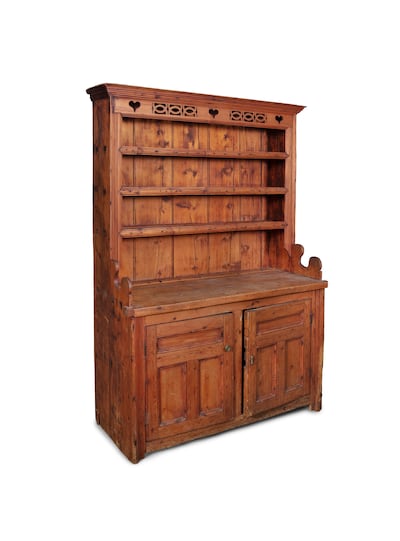Traffic at Keem Bay on Achill Island has been deemed “chaos” at local council meetings due to the number of tourists arriving to catch a glimpse of the setting for the film The Banshees of Inisherin.
It’s not only Tourism Ireland, who is reportedly spending €500,000 to market the location, that is capitalising on the film’s success. Knitwear companies are flogging cable knit jumpers like the ones Colin Farrell wore in the film and houses are marketing themselves as in or near the location. Its lack of an Oscar means the film is in good company joining the likes of Rebel without a Cause, the Shawshank Redemption and the Big Lebowski, who were also passed over and have since become classics.
[ Audacious diamonds and a James Joyce manuscriptOpens in new window ]
Now, original furniture used in the film is being sold by Adam’s of St Stephen’s Green in its Irish Vernacular sale, which will take place on April 12th. All furniture sourced for the film is original, including paintings, vernacular objects and traditional interiors.
Irish vernacular style is best known for the traditional kitchen chair, usually made from locally sourced wood – mostly oak or ash – and often with súgán seats. Other examples of furniture design include the Hedge chair, the settle, the fuel box, the cot and the kitchen dresser, all of which are represented in the sale.
RM Block
Provenance is important when trying to source original Irish vernacular items, as there is lots of stuff online that has been made to look distressed and pass off as old Irish so take heed of the old adage caveat emptor.
A dozen or so items from the film are listed, both furniture and crockery, having been consigned by the person who supplied them to the film’s producers. Of interest are the metamorphic pieces of furniture, previously from the Nore View Folk Museum in Bennettsbridge, Co Kilkenny. A 19th century pine settle bed (lot 135), shows how the design of some traditional Irish furniture was multifunctional. With a six back panel, it operates as a seat that can be easily be turned into a bed with clever hinges (€1,200-€1.500).

Another fabulous metamorphic piece is lot 137, which is an early 19th century table chair where hinges at the back allow the table to sit upright to reveal a seat (€2,000-€3,000). These were from times when large families lived in small cottages and furniture was more functional than aesthetic.
According to the National Museum of Ireland, dressers were the most important item of domestic furniture and were used to show status or wealth, primarily through the display of delph. The large red painted 19th century pine dresser above a fiddle front base, used in the film (lot 118, €3,000-€4,000), would have been common sight in traditional cottages.

Marriage dressers also feature and lot 162, which comes from a private collection in Galway, has a frieze with pierced hearts dating from the 19th century. Another dresser from the film set (lot 194) also has the hearts in frieze (€1,200-€1,800). Delph features strongly in the form of Carrigaline and sponge wear pottery, alongside some really lovely carved sycamore bowls.
Claudia Kinmonth’s book, Irish Country Furniture and Furnishings 1700-2000, is a great resource should you wish to read more on this subject.
The top lot in the sale is an Irish blue limestone fireplace, estimated at €15,000 to €20,000. What makes it special is the piece dates from about 1770, making it over 250 years old, and its rare Kilkenny blue limestone, formed 340 million years ago, is one of the most beautiful and durable of natural stones.
Coupled with that, the insert is carved with rare Sheela na gigs, representing the Celtic stone carvings with exposed female genitalia. “It’s so unique you’re never likely to see the likes of it anywhere ever again,” says James O’Halloran of Adam’s.

Despite the often-naive design language used in much Irish vernacular furniture, bright or rich colour was often used to great effect and many of the pieces in the auction are painted in strong tones of blue, brown, red and particularly green – especially the metamorphic furniture.
Derek Hill’s painting, Still life Study with Artist’s Materials and a Chair (lot 142, €4,000-€6,000), depicts a green country chair so often associated with old Irish kitchens, there’s almost a familiarity to it. This work is evocative of the first time Hill came to paint the remote landscapes on Tory Island. One morning, a group of islanders stopped to see what he had painted and local fisherman and farmer James Dixon, on seeing the artist’s work, commented that he could do better himself. From this, the Tory Island School of Painters was born; a group of islanders who began painting. Dixon himself is featured on the catalogue cover with his Giant Muldoon at the West End Village, Tory Island. Not bad for a farmer who first took up the artist’s brush aged 72 (lot 91, €6,000-€8,000). adams.ie



















